

Les personnes déprimées s'étant suicidées ont toutes au moins un point commun. La conséquence la plus dramatique de la dépression n’est autre que le suicide.

Selon une étude, les personnes déprimées s’étant donné la mort volontairement ont toutefois un point commun. Celui-ci se trouve au niveau de la composition cellulaire de leur cerveau. Les chercheurs ont évoqué le “dysfonctionnement astrocytaire” comme une des causes du suicide. Un nombre réduit d’astrocytes dans le cerveau Souvent nommée dépression clinique, la dépression est un trouble mental dont la conséquence la plus grave possible est le suicide.
Les chercheurs de l’Institut Universitaire en Santé Mentale Douglas de l’Université McGill (Québec) ont en effet évoqué le dysfonctionnement astrocytaire comme étant une des causes de la dépression. Il faut savoir que ces conclusions ont été réalisées grâce à des analyses post-mortem. Renforcer la production d’astrocytes pour éviter un suicide Selon les chercheurs, les tissus cérébraux ayant fait l’objet d’une analyse provenaient de deux groupes de patients. Medical Virtual and Augmented Reality Apps. Extreme Heat of Vesuvius Eruption Turned a Man's Brain to 'Glass' A man who died in Herculaneum during the historic Vesuvius eruption was found with an exploded skull and glass-like brain tissue.

The man died alone, lying on his stomach and probably asleep, as hot ash flowed down from Mount Vesuvius. He was likely the sole victim in an otherwise empty town, abandoned by most of its residents as the volcano began spewing just uphill. Nearly two millennia after that deadly eruption in A.D. 79, a team of Italian researchers has found that there’s more of him left than just his bones. The heat of the eruption, they said, turned the victim’s brain into glass. Communities of Bacteria Have a Working Memory. Biologists studying collectives of bacteria, or “biofilms,” have discovered that these so-called simple organisms feature a robust capacity for memory.
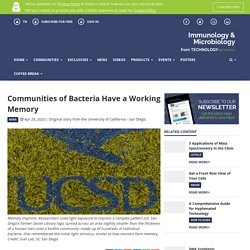
Memory imprints: Researchers used light exposure to impress a complex pattern (UC San Diego’s former Geisel Library logo, spread across an area slightly smaller than the thickness of a human hair) onto a biofilm community—made up of hundreds of individual bacteria—that remembered the initial light stimulus, similar to how neurons form memory. Working in the laboratory of University of California San Diego Professor Gürol Süel, Chih-Yu Yang, Maja Bialecka-Fornal and their colleagues found that bacterial cells stimulated with light remembered the exposure hours after the initial stimulus. The researchers were able to manipulate the process so that memory patterns emerged. The discovery reveals surprising parallels between low-level single-cell organisms and sophisticated neurons that process memory in the human brain. How Organic Memory Devices Can Change Computing. The advent of artificial intelligence, machine learning and the internet of things is expected to change modern electronics and bring forth the fourth Industrial Revolution.

The pressing question for many researchers is how to handle this technological revolution. "It is important for us to understand that the computing platforms of today will not be able to sustain at-scale implementations of AI algorithms on massive datasets," said Thirumalai Venkatesan, one of the authors of a paper published in Applied Physics Reviews. "Today's computing is way too energy-intensive to handle big data. We need to rethink our approaches to computation on all levels: materials, devices and architecture that can enable ultralow energy computing. " Researchers Found That the Brain Jiggles When the Heart Beats, and It's Helping Them Classify Neurons. The brain jiggles when the heart beats, and now, researchers have found a way to use that motion to better study the differences between types of neurons.

In a study appearing March 10 in the journal Cell Reports, researchers find that by analyzing the changes in the waveforms they record from neurons during a heartbeat, they can more accurately classify the different types of neurons in the human brain. This work, they say, could help us better understand how the different types of cells that exist in the brain interact together to produce cognition and behavior. "We were recording neurons from the brain of human patients implanted with electrodes for neurosurgical procedures, and we lined up the neural activity to the heartbeat and saw that many neurons changed their firing pattern every time the heart beats," says Clayton Mosher (@ClaytonPMosher), of Cedars-Sinai Medical Center, who is the joint first author of the study with Yina Wei, of the Allen Institute.
Is Quantum Mechanics Controlling Your Thoughts? Graham Fleming sits down at an L-shaped lab bench, occupying a footprint about the size of two parking spaces.

Alongside him, a couple of off-the-shelf lasers spit out pulses of light just millionths of a billionth of a second long. After snaking through a jagged path of mirrors and lenses, these minuscule flashes disappear into a smoky black box containing proteins from green sulfur bacteria, which ordinarily obtain their energy and nourishment from the sun. Inside the black box, optics manufactured to billionths-of-a-meter precision detect something extraordinary: Within the bacterial proteins, dancing electrons make seemingly impossible leaps and appear to inhabit multiple places at once. Peering deep into these proteins, Fleming and his colleagues at the University of California at Berkeley and at Washington University in St. On the face of things, quantum mechanics and the biological sciences do not mix. Green algae may rely on quantum computing to turn sunlight into food. Surdoués : une intuition à haut potentiel ? ( Psychologies )
L’intuition est une capacité universelle.
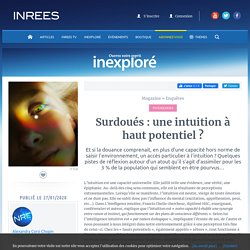
"Love Hormone" Oxytocin Linked to Improved Bonding in Autism. A team led by Professor Kaat Alaerts (KU Leuven) recruited 40 adult men with autism spectrum disorder to take part in their study.
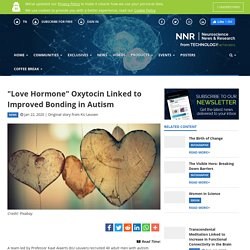
"In a first stage, we examined the amount of oxytocin produced by the participants themselves. The subjects also filled out several questionnaires," Professor Alaerts explains. "An analysis of the data revealed that the amount of oxytocin found in the subjects' saliva was inversely related to their self-reported attachment issues. " In the second stage of the research, the team examined the long-term effects of administering oxytocin through a nasal spray.
This experiment produced remarkable results: the participants who had been given oxytocin for four weeks experienced positive effects until up to a year later.Less repetition, more attachment"We divided the 40 participants into an experimental group and a control group. "Over the course of a full year, we also asked the participants to fill out questionnaires on four different occasions.
A tiny area of the brain may enable consciousness, says "exhilarating" study. This brain circuit works as a sort-of “engine for consciousness,” the researchers say, enabling conscious thought and feeling in primates.
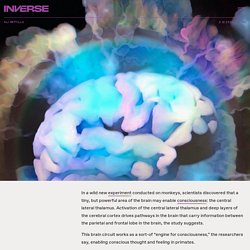
To zero in on this brain circuit, a scientific team put macaque monkeys under anesthesia, then stimulated different parts of their brain with electrodes at a frequency of 50 Hertz. Essentially, they zapped different areas of the brain and observed how the monkeys responded. When the central lateral thalamus was stimulated, the monkeys woke up and their brain function resumed — even though they were still under anesthesia. Seconds after the scientists switched off the stimulation, the monkeys went right back to sleep.
“Science doesn’t often leave opportunity for exhilaration, but that’s what that moment was like for those of us who were in the room,” co-author Michelle Redinbaugh, a researcher at the University of Wisconsin, Madison, tells Inverse. Infographic: The Neurobiology of Suicidal Behavior. Minus et Cortex - Générique. Combien de fois par semaine faut-il faire l'amour pour être heureux. Une nouvelle étude canadienne s’est intéressée à déterminer l’influence que pouvait avoir la fréquence des rapports sexuels au sein d’un couple sur le bien-être.
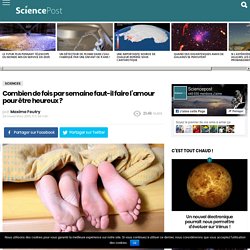
Et, selon les résultats publiés dans la revue Social psychology & Personnality Science, il serait totalement inutile d’excéder une relation sexuelle par semaine pour se sentir heureux. Explications. C’est bien connu, la sexualité joue un rôle fondamental dans l’épanouissement d’un couple. Early whales swam doggy paddle across the ocean from India to Africa. By Michael Marshall Stocktrek Images, Inc. / Alamy Stock Photo Some early whales may have swum using their arms as well as their legs, a bit like a dog paddling in water. Despite this primitive swimming style, they seem to have managed to spread long distances across the ocean, from India to the western tip of Africa at a minimum. How Brains of Doers Differ From Those of Procrastinators. Summary: Researchers use neuroimaging technology to identify brain differences between those who procrastinate and those who are doers.
The study reveals people with poor action control have a larger amygdala, and the connection between the dorsal ACC and amygdala is less pronounced. Source: RUB. Scientists Have Found Secret Tunnels Between The Skull And The Brain. Did you know you have tiny tunnels in your head? That's OK, no one else did either until recently! But that's exactly what a team of medical researchers have just found in mice and humans - tiny channels that connect skull bone marrow to the lining of the brain. The research shows they may provide a direct route for immune cells to rush from the marrow into the brain in the event of damage. Previously, scientists had thought immune cells were transported via the bloodstream from other parts of the body to deal with brain inflammation following a stroke, injury, or brain disorder. Neurons that 'Jumpstart' Breathing at Birth Identified.
Neurons of the parabrachial complex are important for breathing. Credit: Meike van der Heijden/the Zoghbi lab/eLife, 2018 The common expression, ‘As easy as breathing,’ is truly misleading. How We Remember What We Read. By comparing participants' brain activity to how well they remembered the essays they read, the researchers found successful memory of the text was associated with deactivation of two sets of brain regions: the salience network at the sentence level and the default mode network at the paragraph level. These deactivations may indicate a mechanism by which the brain filters out irrelevant information during reading in order to focus on committing the text to memory. Credit: Naoyuki Sato The results of two human experiments published in eNeuro reveal patterns of brain activity associated with successful memory of a just-read text.
The research provides new insight into the memory processes involved in natural reading. In one experiment, Naoyuki Sato and colleagues measured the electrical activity generated participants' brains and tracked their eye movements as they read 4,000- to 8,000-word essays. This article has been republished from materials provided by the Society for Neuroscience. A Molecular Reason Why Obese People Have Trouble Losing Weight. Controlling electric signals in the body could help it heal. The brain's 7D sandcastles could be the key to consciousness. By Anil Ananthaswamy EDWIN ABBOTT, in his 1884 book Flatland, created a fictional 2D landscape full of lines, triangles, squares and circles that have no notion of up or down.
One day, a 3D Sphere visits Flatland and whisks away a Square to a higher dimensional world. Square learns that Flatlanders are mere 2D projections of 3D beings. He then has the audacity to suggest that Sphere may be a shadow too – of a shape in four dimensions. “The very idea of it is utterly inconceivable,” says the appalled Sphere. Key Molecule Responsible for Learning and Memory Discovered. Unlike old dogs, old adults can indeed learn new tricks thanks to a protein molecule called netrin. Netrin is known to help set up the healthy nervous system in an infant's developing brain by directing brain cells to make appropriate connections with other brain cells. New research conducted by scientists at The Neuro has found that netrin in the adult brain can make neural connections stronger, which is crucial not only for learning new tricks but also for maintaining a good memory. Learning Disability Dyscalculia Explains How a Smart Kid Can Be So Bad at Math.
Steph Zech graduated from high school this spring with an admirable academic record. She especially loved chemistry, writing and literature — though she has some reservations about Dante. A bright and diligent student, she took two Advanced Placement classes her senior year, sailing through both. But when it comes to math, Steph has struggled mightily. At age 17, she still counts on her fingers to add 3 and 5. Procrastination : c'est la taille (de l'amygdale) qui compte. Non, les plus procrastinateurs d'entre nous ne sont pas ceux qui ont le plus gros poil dans la main, mais la plus grosse amygdale dans le cerveau, à en croire une équipe de chercheurs allemands. Dans une étude publiée dans la revue Psychological Science, intitulée The Structural and Functional Signature of Action Control, les scientifiques racontent comment ils ont cherché à comprendre si la procrastination peut trouver une explication anatomique, et non pas uniquement psychologique.
How We Remember What We Read. Why a “genius” scientist thinks our consciousness originates at the quantum level. Sleep Deprivation Effective as an Anti-Depressant for Nearly Half of Depressed Patients. Sleep deprivation – typically administered in controlled, inpatient settings – rapidly reduces symptoms of depression in roughly half of depression patients, according the first meta-analysis on the subject in nearly 30 years, from researchers at the Perelman School of Medicine at the University of Pennsylvania. The brain's 7D sandcastles could be the key to consciousness. After 15 Years in a Vegetative State, Scientists Partly Restore Consciousness in Patient. This figure shows information sharing across all electrodes before (left) and after vagus nerve stimulation.
The yellow and orange colors on the right indicate an increase of connectivity among posterior parietal regions. En quelle langue pensent les sourds. Why scientists are transplanting artificially grown “brains” into living brains. Science is awesome, but it can involve doing some pretty strange things. Un microbiote dans le cerveau ! Depuis quelques années, on entend beaucoup parler du microbiote intestinal, ces milliers de milliards de bactéries qui peuplent notre conduit digestif et qui semblent avoir un impact sur le cerveau, notamment sur notre humeur ou notre comportement alimentaire. The first “social network” of brains lets three people transmit thoughts to each other’s heads.
Des neuroscientifiques ont découvert une différence dans les cellules cérébrales humaines les rendant uniques. Une synthèse inédite des connaissances actuelles sur la conscience animale. Petits mais géniaux: dans la tête des bébés. Bébés humains et chimpanzés partagent un langage commun. What if Consciousness is Not What Drives the Human Mind? Mild Exercise Rapidly Stimulates Hippocampus to Improve Cognitive Ability and Memory. How a positive mind really can create a healthier body. A new way to capture the brain’s electrical symphony. Autonomous sensory meridian response. L’impossible modélisation de la société.
Www.forbes. ADHD drugs increase brain glutamate, predict positive emotion in healthy people. Mysterious Dolphins. En vidéo : l’orgasme d’une femme… filmé par IRM. Neuroscientists have followed a thought as it moves through the brain. General anesthetics do more than put you to sleep. Mitochondrial metabolite linked to regulation of neurotransmission. Researchers find potential path to repair multiple sclerosis-damaged nerves. Meet the Parasites That Control Human Brains - The Crux. Beta of Neurodata Without Borders Software Now Available. Dutch courage—Alcohol improves foreign language skills. Scientists have recreated déjà vu in the lab, and it's less spooky than you'd think. La limérence, la magie de tomber amoureux. Reached Via a Mind-Reading Device, Deeply Paralyzed Patients Say They Want to Live.
Question de la semaine : comment s’explique la sensation de “déjà-vu” Alexa and Siri in our head: Where voice recognition occurs in the brain. ?articles. Scientists Successfully “Inject” Information Directly Into Monkeys' Brains. Problematic alcohol use linked to reduced hippocampal volume. New approaches in neuroscience show it's not all in your head.
Quand la réalité virtuelle aide à révéler les secrets de notre mémoire. Brain Mechanism That Inhibits Unwanted Memories Uncovered. Even without nudging blood pressure up, high-salt diet hobbles the brain. Brain Cells Share Information With Virus-Like Capsules. Scientists just changed our understanding of how anaesthesia messes with the brain. New research into the influence of alcohol on sexual objectification. Fasting may boost brainpower by giving neurons more energy. Neurons have the right shape for deep learning. The human brain can 'see' what is around the corner. Brain Circuit Dedicated to Retrieving Memories Discovered at MIT. Brain scans reveal why rewards and punishments don't seem to work on teenagers. New Function of the Hippocampus Revealed. Les langues humaines dévoilent leur lien avec le cerveau.
La science dit que le silence est beaucoup plus important pour notre cerveau que nous le pensons. 'Mind's eye blink' proves 'paying attention' is not just a figure of speech. If Brains are Computers, Who Designs the Software? With Daniel Dennett Video. Hypnic Jerks - The Reason Why We Twitch Before Falling Asleep. We May Finally Have a Map That Shows How Memories Are Made. Soon, We May Be Able to Access Our Memories From Early Childhood.
TFH-derived dopamine accelerates productive synapses in germinal centres. Huge dose of brain chemical dopamine may have made us smart. Les neurosciences émotionnelles d'Antonio Damasio. What if consciousness is not what drives the human mind? Boosting brain's 'executive center' may prevent anxiety. Social norms elicit activity in distinct brain regions. Astrocytes Regulate Breathing Rhythms. Hommes et femmes : quelles sont les hormones du désir ? Two alcoholic drinks a day are good for your brain. No reason to believe the pineal gland alters consciousness by secreting DMT, psychedelic researcher says. Quelle est la nourriture du cerveau. Nice Brains Finish Last. Here's How Space Travel Changes the Brain. Distinct deposition of amyloid-β species in brains with Alzheimer’s disease pathology visualized with MALDI imaging mass spectrometry.
Dogs Have the Most Neurons, Though Not the Largest Brain: Trade-Off between Body Mass and Number of Neurons in the Cerebral Cortex of Large Carnivoran Species. Psychological Study Reveals: Open Minded People Live In A Completely Different Reality! Take a 3D Voyage Through the Brain Video. Take a 3D Voyage Through the Brain Video. The Science of the Rorschach Blots - Neuroskeptic.